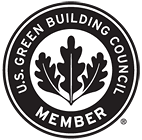Green Building
More about green building
You can’t pick up a newspaper or turn on the TV these days without hearing bad news about rising energy prices and climate change. But what can the owner or manager of a commercial facility do about these global issues? Is it possible to improve your bottom line and boost your competitive position while reducing your ‘carbon footprint’ and helping to protect our environment?
Most people are surprised to learn that commercial buildings and industrial facilities account for 45 percent of greenhouse gas emissions in the United States. In fact, the EPA estimates we could save at least $20 billion a year if the energy efficiency of our commercial and industrial facilities were improved by just 10 percent. The Building Owners and Managers Association (BOMA) reports that energy accounts for “30 percent of a typical building’s total costs” and is “the single largest and most controllable operating cost in an office building.” Experts expect the size of these numbers to grow as energy costs continue to climb faster than the rate of inflation.
The good news is that these large and growing energy costs are, as BOMA says, the “most controllable” expenses on the balance sheet. And across the country, savvy owners and managers are finding there are significant profits and business advantages to be gained by “going green” to reduce these costs – if you know where to look.
Accurate Assessment of your building’s current energy performance is the critical first step in any successful plan to reduce costs and improve business efficiency. Without a “big picture” understanding of the energy issues you’re trying to correct, repairs and retrofits can produce disappointing results, or even make the situation worse. Furthermore, if decision makers don’t understand the full scope of the problem, it can be difficult to access the finances and resources necessary to execute an effective plan.
Infrared Reveals Building Thermal Performance
That’s why more and more facility managers are turning to professional infrared building envelope analysis as the first step in their efforts to reduce escalating energy costs. This cutting-edge thermographic technology delivers a highly accurate and comprehensive picture of the facility’s thermal performance, producing a professional assessment of all components in the building system. It’s an invaluable aid to any green design project. Infrared building envelope testing can also help “get everybody on the same page” by revealing expensive building energy losses with the dramatic visual evidence of full-color thermographic images. When chronic heat and energy losses become visible for all to see, the connection between energy management and financial responsibility becomes undeniable – and funding for effective action becomes available.
